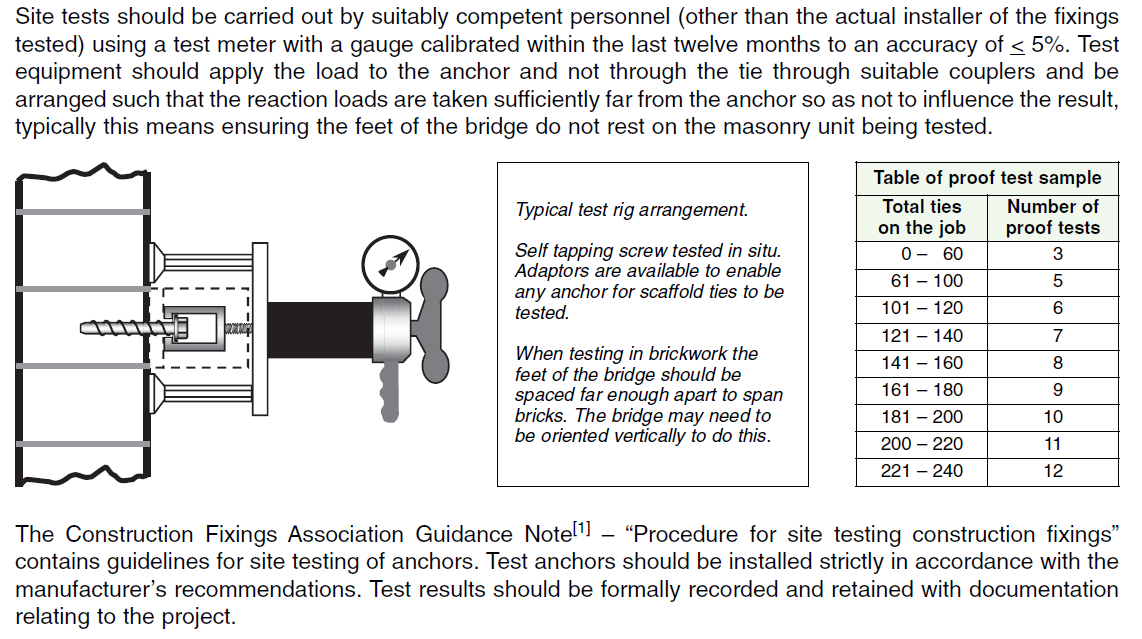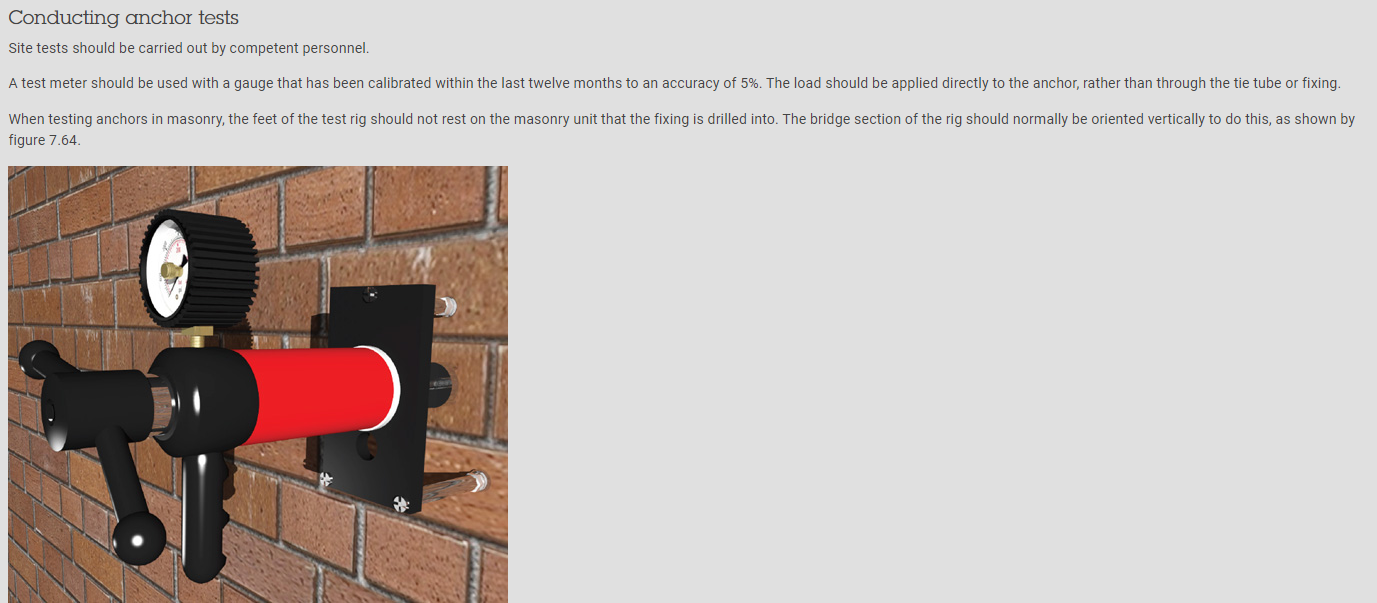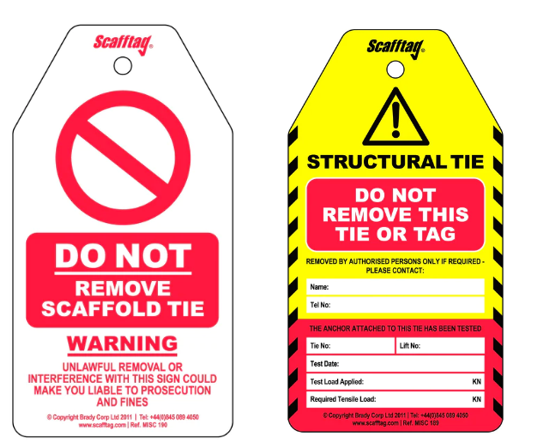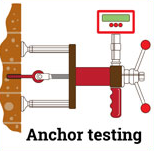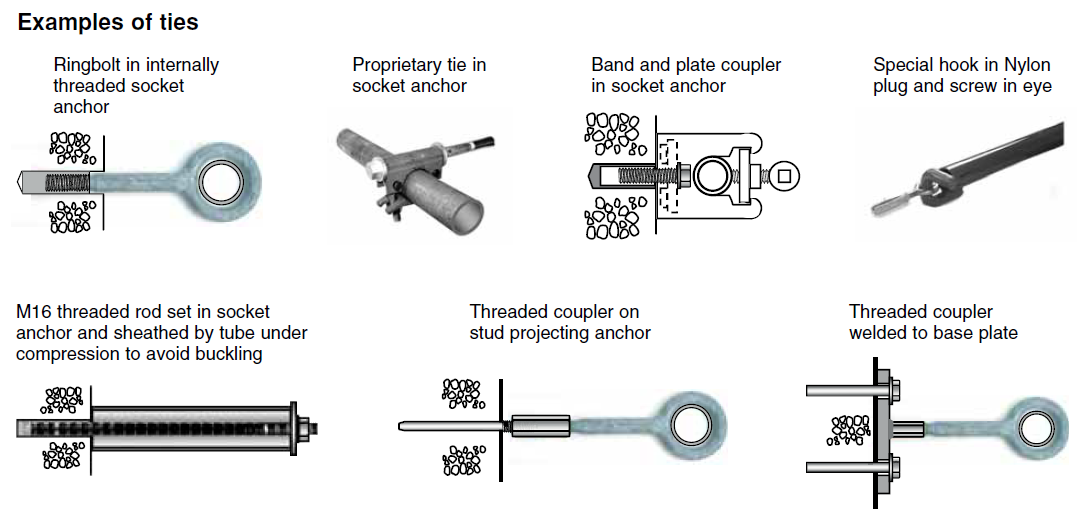Title Page
-
Site conducted
-
Test report reference number
-
Anchors Test Procedure Site tests should be carried out by suitably competent personnel (other than the actual installer of the fixings tested) using a test meter with a gauge calibrated within the last twelve months to an accuracy of < 5%. Test equipment should apply the load to the anchor and not through the tie through suitable couplers and be arranged such that the reaction loads are taken sufficiently far from the anchor so as not to influence the result, typically this means ensuring the feet of the bridge do not rest on the masonry unit being tested.
-
Project type
- Yes
- No
- New Build
- Refurbishment
- Demolition
- Other
-
Testing Anchors
- ''Preliminary'' Tests- are used to check the suitability of particular fixing in the base material and determine allowable loads.
- ''Proof'' Tests -are needed to check the quality of installation of chosen anchors.
- Other
-
Type of pull-out tester- make and model
-
Tie Pull tester calibration certification
- Light Duty Ties SWL 3.5kN (350kg)
- Standard Duty Ties SWL 6.1kN (610kg)
- Heavy Duty Ties SWL12.2 kN (1220kg)
- Other
- Yes
- No
- Other
-
Date of last tie pull tester calibration
-
Conducting Anchor Test
-
Type of Anchor/Ties Test
- Preliminary Test - preliminary tests are performed on anchors before the scaffold is erected at a site. This is normally required when tying into masonry or other base materials where the anchor manufacturer cannot provide characteristic load data.
- Proof Test- On all jobs, proof tests of scaffold ties are required. These proof tests are not designed to be a check on the manufacturer’s load test data, but a check that the anchors have been installed correctly (to the manufacturer’s recommendations) and that the substrate is capable of taking 1.25 times the working load of each anchor. Proof testing to 1.25 times the working load rather than just the working load gives a ‘safety factor’ to the installation of the anchor tie in the substrate.
- Other
- Structural Tie Pull Test
-
Conducted on
-
Prepared by
-
Client Name
-
Witnessed by Full Name
-
Scaffold Location
-
All anchors that have been proof loaded should be clearly identified with a tag showing the date of test and the test load, any anchors failing the test should be tagged as such.
Anchorage Recommended Loads and Design Approach
-
A minimum of three anchors or 5% of the anchors installed (whichever is the greater number) are to be tested per scaffold. It is best practice to spread these tests around the scaffold, in particular if different anchors have been used in different sections or if these anchors have been installed by different teams. Should a scaffold tie fail a pull test, then the frequency of anchor testing doubles.
The failure of an anchor in proof testing is a serious issue and requires the investigation of the cause(s) of failure and an increase in testing rate as follows:
One failure – double the test rate to 1 in 10 and at least 6.
Two failures – double again to 1 in 5 and at least 12
More than 2 failures – test 100% of the job, review the fixing specification and installation method. -
Tie patterns for three classes of tie based on working loads in pure tension as
- Light Duty Ties SWL 3.5kN (350kg)
- Standard Duty Ties SWL 6.1kN (610kg)
- Heavy Duty Ties SWL12.2 kN (1220kg)
- Other
- Yes
- No
- Other
-
Examples of Ties
-
Base Material
- Concrete- Anchor type : Drop in anchor, Self-tapping screws, Nylon anchors with screw-in eyes , Resin anchors
- Brickwork and stonework- Self tapping screws, Self-tapping screws with resin, Nylon anchors with screw-in eyes, Resin anchors
- Concrete blockwork- Self-tapping screws, Nylon anchors, Resin anchors
- Lightweight blockwork- Check strength and refer to manufacturer
- Timber- Screw in eyes, Self-tapping screws
- Steelwork- Self-drilling & tapping screws, Bolts for hollow sections
- Other
-
Thickness (mm)
-
Nominal Strength/Grade (N/mm2)
-
Solid/Hollow
Fixing Details
-
Scaffold Anchor Ties Tested
- Pass
- Fail
- N/A
- Ringbolt internally threaded socket anchor
- Proprietary tie in socket anchor
- Band and plate coupler in socket anchor
- Special hook in Nylon plug and screw in eye
- M16 threaded rod set in socket anchor and sheathed by tube under compression to avoid buckling
- Threaded coupler on stud projecting anchor
- Threaded coupler welded to base plate
- Other (specify)
-
Hole Diamention (mm)
-
Hole Depth (mm)
-
Applied Torque (kN)
-
Tensile Load (kN)
-
Tie pull test 1
- Pass
- Fail
- N/A
- Ringbolt internally threaded socket anchor
- Proprietary tie in socket anchor
- Band and plate coupler in socket anchor
- Special hook in Nylon plug and screw in eye
- M16 threaded rod set in socket anchor and sheathed by tube under compression to avoid buckling
- Threaded coupler on stud projecting anchor
- Threaded coupler welded to base plate
- Other (specify)
-
Tie test location
-
Tie pull test 2
- Pass
- Fail
- N/A
- Ringbolt internally threaded socket anchor
- Proprietary tie in socket anchor
- Band and plate coupler in socket anchor
- Special hook in Nylon plug and screw in eye
- M16 threaded rod set in socket anchor and sheathed by tube under compression to avoid buckling
- Threaded coupler on stud projecting anchor
- Threaded coupler welded to base plate
- Other (specify)
-
Tie test location
-
Tie pull test 3
- Pass
- Fail
- N/A
- Ringbolt internally threaded socket anchor
- Proprietary tie in socket anchor
- Band and plate coupler in socket anchor
- Special hook in Nylon plug and screw in eye
- M16 threaded rod set in socket anchor and sheathed by tube under compression to avoid buckling
- Threaded coupler on stud projecting anchor
- Threaded coupler welded to base plate
- Other (specify)
-
Tie test location
-
Tie pull test 4
- Pass
- Fail
- N/A
- Ringbolt internally threaded socket anchor
- Proprietary tie in socket anchor
- Band and plate coupler in socket anchor
- Special hook in Nylon plug and screw in eye
- M16 threaded rod set in socket anchor and sheathed by tube under compression to avoid buckling
- Threaded coupler on stud projecting anchor
- Threaded coupler welded to base plate
- Other (specify)
-
Tie test location
-
Tie pull test 5
- Pass
- Fail
- N/A
- Ringbolt internally threaded socket anchor
- Proprietary tie in socket anchor
- Band and plate coupler in socket anchor
- Special hook in Nylon plug and screw in eye
- M16 threaded rod set in socket anchor and sheathed by tube under compression to avoid buckling
- Threaded coupler on stud projecting anchor
- Threaded coupler welded to base plate
- Other (specify)
-
Tie test location
-
Tie pull test 6
- Pass
- Fail
- N/A
- Ringbolt internally threaded socket anchor
- Proprietary tie in socket anchor
- Band and plate coupler in socket anchor
- Special hook in Nylon plug and screw in eye
- M16 threaded rod set in socket anchor and sheathed by tube under compression to avoid buckling
- Threaded coupler on stud projecting anchor
- Threaded coupler welded to base plate
- Other (specify)
-
Tie test location
-
Tie pull test 7
- Pass
- Fail
- N/A
- Ringbolt internally threaded socket anchor
- Proprietary tie in socket anchor
- Band and plate coupler in socket anchor
- Special hook in Nylon plug and screw in eye
- M16 threaded rod set in socket anchor and sheathed by tube under compression to avoid buckling
- Threaded coupler on stud projecting anchor
- Threaded coupler welded to base plate
- Other (specify)
-
Tie test location
-
Tie pull test 8
- Pass
- Fail
- N/A
- Ringbolt internally threaded socket anchor
- Proprietary tie in socket anchor
- Band and plate coupler in socket anchor
- Special hook in Nylon plug and screw in eye
- M16 threaded rod set in socket anchor and sheathed by tube under compression to avoid buckling
- Threaded coupler on stud projecting anchor
- Threaded coupler welded to base plate
- Other (specify)
-
Tie test location
- Pass
- Fail
- N/A
- Ringbolt internally threaded socket anchor
- Proprietary tie in socket anchor
- Band and plate coupler in socket anchor
- Special hook in Nylon plug and screw in eye
- M16 threaded rod set in socket anchor and sheathed by tube under compression to avoid buckling
- Threaded coupler on stud projecting anchor
- Threaded coupler welded to base plate
- Other (specify)
-
Tie pull test 9
- Pass
- Fail
- N/A
- Ringbolt internally threaded socket anchor
- Proprietary tie in socket anchor
- Band and plate coupler in socket anchor
- Special hook in Nylon plug and screw in eye
- M16 threaded rod set in socket anchor and sheathed by tube under compression to avoid buckling
- Threaded coupler on stud projecting anchor
- Threaded coupler welded to base plate
- Other (specify)
-
Tie test location
-
Tie pull test 10
- Pass
- Fail
- N/A
- Ringbolt internally threaded socket anchor
- Proprietary tie in socket anchor
- Band and plate coupler in socket anchor
- Special hook in Nylon plug and screw in eye
- M16 threaded rod set in socket anchor and sheathed by tube under compression to avoid buckling
- Threaded coupler on stud projecting anchor
- Threaded coupler welded to base plate
- Other (specify)
-
Tie test location
-
Result of Test
- Pass
- Fail
- N/A
- Ringbolt internally threaded socket anchor
- Proprietary tie in socket anchor
- Band and plate coupler in socket anchor
- Special hook in Nylon plug and screw in eye
- M16 threaded rod set in socket anchor and sheathed by tube under compression to avoid buckling
- Threaded coupler on stud projecting anchor
- Threaded coupler welded to base plate
- Other (specify)
-
Inspector signature






